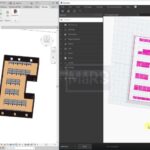Many wonder what the B.I.M. methodology is. This revolutionary system is a collaborative work method that is applied to architecture and engineering projects. This method allows us to transfer all the information to an Intelligent Three-Dimensional Model, that is, we can recreate all the phases of the process in 3D, taking into account all the qualities of the materials (geometric dimensions, physical and thermal capacities, etc.) And the qualities of the project (costs, execution times, etc.).
This results in a 3D recreation of the project throughout the construction process and its later life. In addition, data layers can be added to each phase, such as costs, to increase the information available.
BIM has two advantages that make it one of the most interesting methods internationally. On the one hand, a large amount of information and the ability to connect different phases with each other, achieving a substantial improvement in quality and efficiency.
On the other, BIM infrastructure planning allows all the agents that are part of the project to work simultaneously and in real-time, being interconnected and guaranteeing the integrity and updating of all the information.
So, why it is essential?
Multidisciplinary and collaborative work. It is one of the main benefits of the BIM methodology, through a single platform the different agents involved in the construction process can work in the same tool, sharing and integrating information in real-time. This facilitates the control, management, and analysis of projects in each of their phases and areas.
Reduction of errors. The information that is generated with the BIM methodology is much more exhaustive and reliable. Before starting the project, we have all the information and we can check if there are any integration problems between the different elements. This minimizes human errors and costs and increases project transparency.
Covers the entire life of the building. The BIM methodology is not just a tool to define a project and carry out its design and construction. The possibility of entering information allows better monitoring of the life of the building during its operation. And if it is necessary to demolish it, thanks to the data obtained, it is possible to know what the best way is to do it.
Know the energy impact. One of the most significant advantages is that we can know the energy impact of each of the materials that make up the work. In this way, carbon emissions can be controlled from the beginning, and smart buildings designed that are increasingly sustainable and efficient. Therefore, the benefits of the BIM method last over time.
Time and cost savings. This new way of working allows the automatic generation of all project documentation. This reduces costs and time.
Read also: Top 5 Important Benefits Of BIM For Fire Safety
Is it really reduce cost? We can say YES. But how and whose?
Cost reduction for the developer
Whether they are a public or private developer, they obtain great savings because, already in premature phases of the project, they can choose between different solutions for energy saving and functional and structural optimization, which together with greater work control means that the final budget does not have deviations and ensure deadlines, especially in rehabilitation works where it is more difficult to have a forecast of everything that may happen.
Cost reduction for architect or engineer
An architecture or engineering studio comes to have large expenses due to the changes that projects have throughout their development since they are hours that must be dedicated to having adequate document management.
How does the BIM method reduce costs for them? By working with the BIM methodology, change management is much more optimal, and changes are made without the effort that the traditional way entailed. The other great benefit is the increase in the quality of the projects since greater coherence is achieved, which with two-dimensional models was almost impossible.
In the implementation, the savings come in the reduction of the hours that are invested in solving the problems that arise due to inconsistencies and indefiniteness of the projects. With BIM implementation, they are reduced between 75% and 90%, in this way the facultative management can focus on its own functions, such as controlling the execution of the works more effectively, thus achieving much higher quality and control than the traditional ones. Also avoiding budget deviations.
Might You Have Missed:
Top 4 Benefits Of BIM For Contractors You Need To Know
Cost reduction for the builder
Finally, the builder can also benefit from how the BIM method reduces costs. A builder can save thanks to managing a BIM model in three main points: managing the work, thanks to the 4D BIM modeling, in a more optimal way; with the 5D to be able to measure in a faster and more precise way without having to repeat jobs; and above all, detect the collisions between disciplines: architecture, structure, and facilities. Being able to foresee the most optimal and economical solutions in advance. This last point should have already been reviewed by the technicians, but if they have not worked on a BIM model, the builder has the advantage that he must strengthen his position with respect to the competition.
Hence, To start a BIM project it is necessary to have a specialized team with the necessary knowledge regarding the necessary standards and requirements.



